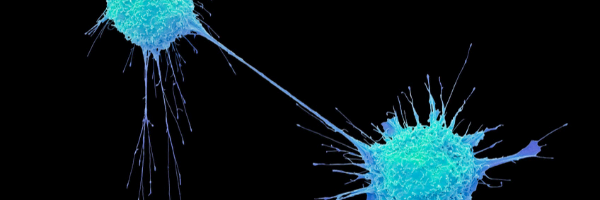Cancer Development
In order to treat or prevent cancer it is important to understand how and why cancer develops in the first place. Cancer is a disease in which abnormal cells divide uncontrollably and destroy body tissue.
Cancer cells exist normally at the cellular level throughout life. Fortunately, the body is usually capable of removing cancer cells through built in control mechanisms, either by the cancer cells self-destructing via genetically programmed “apoptosis”, or by the immune system recognizing the abnormal cancer cell and killing it via a type of white blood cell called natural killer (NK) cells. These are the same cell types that kill viruses. It also uses large cells called macrophages that literally gobble up cancer cells.
Cancer cells evade the natural control mechanisms when conditions allow. It could be said that cancer cells “adapt” to certain environmental stressors that force the cell to either adapt or die. Once the cancer cells pass a certain point they become a malignant tumor with uncontrolled growth, create new blood vessels to supply it (angiogenesis) and spread throughout the body.
Early in the cancer process, circulating tumor cells (CTCs) and circulating stem cells (CSCs) that can mutate into cancer cells are shed from the primary cancer into the bloodstream. These circulating cells can remain dormant for many years until turning into cancer, which is known as a relapse. Worse yet, these cells can adapt to become resistant to chemotherapy agents thus becoming harder and harder to kill.
When healthy cells turn cancerous they change genetically and metabolically. Cancer promoting genes are turned on, enzymes change their activity and certain metabolic pathways increase while others shut off completely.
While healthy cells use aerobic oxygen-requiring pathways to generate energy, cancer cells shift to anaerobic pathways that do not require oxygen while using glucose at a rate of 10-50 times higher than healthy cells. They also take up tremendous amounts of iron. Cancer does not like oxygen and it loves sugar and iron.
Cancer cells also secrete an enzyme called nagalase that helps them hide from the immune system. A cellular protein called globulin component macrophage activating factor (GcMAF) instructs macrophages to ingest cancer cells but nagalase renders GcMAF unable to function normally.
Some cancer growth is fueled by hormones. This does not necessarily mean the hormone caused the cancer, but once the abnormal cell has proliferated it becomes sensitive to the hormone.
Triggers for cancer initiation and propagation include environmental toxins such as smoking, alcohol, certain chemicals and heavy metals, infections, ionizing radiation, and genetic mutations. Obesity, impaired circulation, inflammation, oxidation, and hormonal imbalances encourage cancer growth. So do lifestyle factors such as little exercise, poor diet, not enough good sleep and excess stress.
Conventional Treatment Goals
The conventional “pillars of cancer treatment” include surgery, chemotherapy and radiation. Surgery is done to either remove the cancer entirely or at least remove the bulk of it and gather pathologic information. Chemotherapy is designed to kill rapidly dividing cells such as cancer, but unfortunately this is why it commonly effects healthy cell types that also divide rapidly, especially the gut, bone marrow and immune system. Ionizing radiation such as gamma rays have enough energy to detach electrons from atoms or molecules, causing sufficient damage to cancer cell DNA to cause apoptosis or slow growth.
Aside from traditional gamma “radiation” treatments, there are new, relatively safe and effective treatment options worth considering for some cancers:
Ionizing Treatments
- Proton Beam Therapy
- Brachytherapy
Non-Ionizing Treatments
- Freezing – CryoAblation
- Heat / Hyperthermia – Oncotherm
- Ultrasound – Sonodynamic
- Radiofrequency Ablation
We strongly encourage all patients with cancer to seek counsel from surgeons and oncologists so as to understand the risks and benefits of conventional treatment. Our patients with cancer are usually getting conventional treatments, have declined conventional treatments, or come to us because conventional treatments have failed.
Alternative or Complementary Treatment Goals
In general the goal of cancer treatment or prevention is to support apoptosis, kill the cancer cells, block cancer growth, boost immune system strength and recognition of cancer cells, and change the terrain that encourages cancer growth. Another important goal is supporting the patient so they are more likely to withstand the various treatments.

